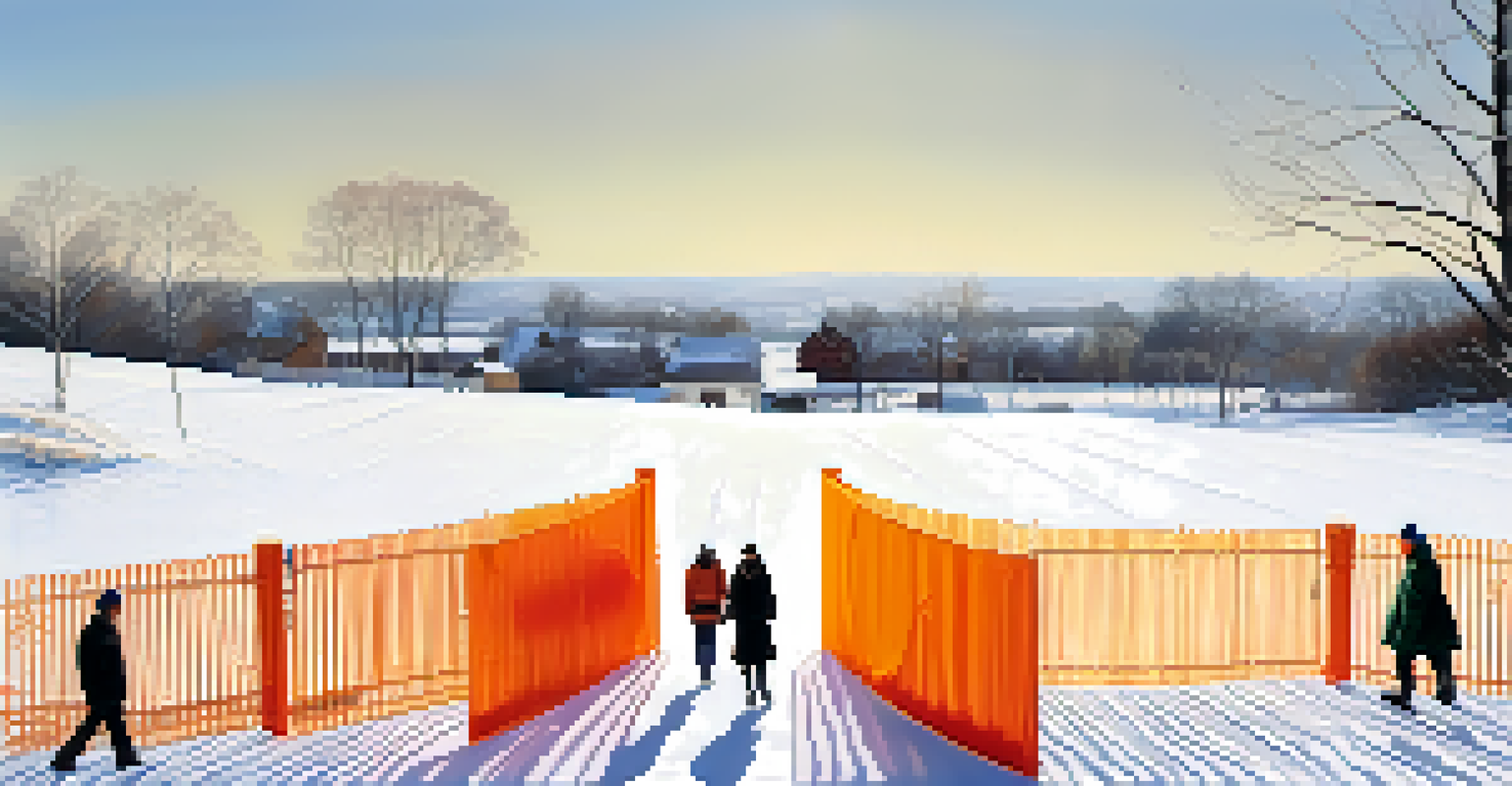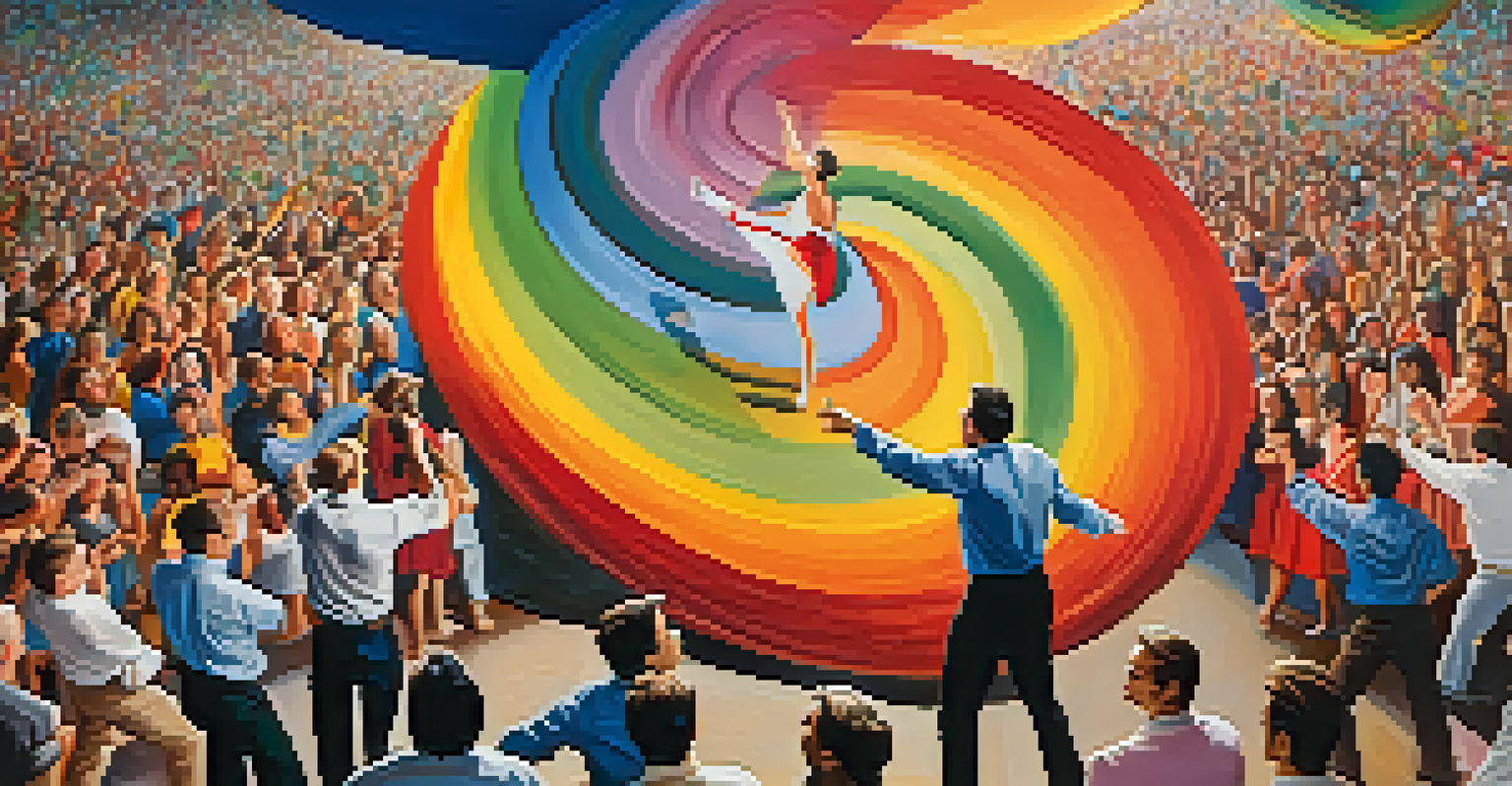Analyzing Iconic Performance Art Pieces: A Critical Overview

What is Performance Art? Understanding the Basics
Performance art is a captivating blend of visual art and live action, where the artist's body becomes the medium. Unlike traditional art forms, it engages the audience in real-time, often challenging their perceptions and emotions. This genre emphasizes the experience rather than the final product, making each performance unique and ephemeral.
Art is not a mirror held up to reality, but a hammer with which to shape it.
At its core, performance art can transcend cultural boundaries and provoke thought, often addressing societal issues, identity, and human emotion. For instance, artists might use their own bodies to explore themes of vulnerability or resilience, inviting viewers to reflect on their own experiences. This interactive aspect is what sets performance art apart from other art forms.
Famous performance artists like Marina Abramović and Yoko Ono have pushed these boundaries even further, creating pieces that linger in the public consciousness. Their work demonstrates how performance art can serve as a powerful medium for social commentary, making it a vital part of contemporary art discussions.
Marina Abramović: The Artist is Present
One of the most iconic performance pieces is Marina Abramović's 'The Artist is Present,' held at the Museum of Modern Art in 2010. In this piece, Abramović sat silently across from participants, inviting them to engage in a shared moment of vulnerability. The simplicity of the act—just sitting and looking into each other's eyes—created a powerful emotional connection.

This performance highlighted the concept of presence and attention in a world saturated with distractions. Many visitors reported feeling a profound sense of intimacy and connection, not just with Abramović but with their own emotions. It was a brilliant reminder of how human interaction can be both transformative and healing.
Performance Art Engages Audiences
Performance art transforms the viewer's role from a passive observer to an active participant, fostering a dynamic interplay between artist and audience.
Through 'The Artist is Present,' Abramović challenged viewers to confront their own feelings and the nature of human connection. The piece sparked discussions about the role of the artist and the audience, reinforcing performance art's ability to create a space for reflection and dialogue.
Yoko Ono's Cut Piece: A Bold Statement on Vulnerability
Yoko Ono's 'Cut Piece,' first performed in 1964, is a striking exploration of vulnerability and the power dynamics between performer and audience. In this piece, Ono invited spectators to come up and cut away pieces of her clothing, literally stripping away her layers. This act served as a metaphor for the societal pressures placed on women and the objectification of the female form.
The artist is the creator of beautiful things. The critic is one who can translate the beautiful into words.
The discomfort of the performance was palpable, as audiences grappled with their own complicity in the act of cutting. Ono's willingness to expose herself both physically and emotionally prompted viewers to confront their feelings about consent, power, and intimacy. The piece remains relevant today, resonating in discussions around feminism and body politics.
Ono's 'Cut Piece' not only challenged the boundaries of performance art but also encouraged ongoing dialogue about the experiences of women in society. It exemplifies how art can provoke thought and inspire change, making it a pivotal moment in the history of performance art.
Christo and Jeanne-Claude: The Gates
In 2005, the artists Christo and Jeanne-Claude transformed Central Park with their installation 'The Gates,' a monumental work that consisted of 7,503 saffron-colored fabric gates. While not a performance in the traditional sense, the installation created a unique experience for visitors, inviting them to walk through the park in a new way. This ephemeral event lasted only 16 days, emphasizing the fleeting nature of art.
The Gates encouraged viewers to engage with their environment and experience the park from a fresh perspective. The vibrant colors contrasted with the winter landscape, prompting conversations about art's role in public spaces. It highlighted how art can foster community and connection, allowing people to come together and appreciate beauty in everyday life.
Vulnerability in Performance Art
Works like Yoko Ono's 'Cut Piece' exemplify how performance art explores themes of vulnerability and societal pressures, prompting deep reflection among viewers.
By wrapping the familiar in vibrant fabric, Christo and Jeanne-Claude challenged our perceptions of space and art. Their work embodies the essence of performance art: a momentary experience that leaves a lasting impact on the participant's memory.
The Role of Audience in Performance Art
One of the most intriguing aspects of performance art is the role of the audience. Unlike traditional art forms, where the viewer is often a passive observer, performance art invites active participation and engagement. The audience's reactions can shape the performance, creating a dynamic interplay between the artist and those witnessing the work.
This interaction can lead to unexpected outcomes, as artists often rely on the energy and emotions of the audience to inform their performances. For example, in interactive pieces, the audience may be invited to join in, blurring the lines between creator and spectator. This aspect of performance art can create a communal experience, fostering a sense of connection among participants.
By involving the audience, performance art emphasizes the shared human experience, encouraging reflection on the nature of existence and our relationships with others. It transforms the act of viewing into a dialogue, ultimately enriching the overall impact of the artwork.
The Evolution of Performance Art through the Decades
Performance art has evolved significantly since its inception in the 1960s, adapting to cultural shifts and technological advancements. Early pioneers like Allan Kaprow introduced the concept of 'Happenings,' which blurred the lines between art and life. These spontaneous events encouraged audience participation and set the stage for future performance artists to explore new dimensions.
In the 1980s and 1990s, performance art became more politically charged, with artists like Guillermo Gómez-Peña addressing issues such as immigration and identity. This era saw a surge of diverse voices, as artists from various backgrounds used performance as a tool for social commentary. The evolution of performance art reflects broader societal changes and the ongoing quest for self-expression.
Digital Media Expands Reach
The rise of digital media allows performance artists to livestream their work, making it more accessible and fostering a global art community.
Today, performance art continues to thrive, often incorporating multimedia elements and technology. Artists are exploring new mediums while remaining grounded in the essence of live performance. This adaptability ensures that performance art remains relevant, engaging, and impactful in a rapidly changing world.
The Impact of Digital Media on Performance Art
The rise of digital media has profoundly influenced performance art, expanding its reach and redefining how audiences engage with it. Artists can now livestream performances, allowing viewers from around the globe to witness their work in real-time. This accessibility has democratized performance art, breaking down geographical barriers and fostering a more inclusive art community.
Additionally, social media platforms have become vital tools for artists to promote their work and connect with audiences. By sharing snippets of performances or behind-the-scenes moments, artists can cultivate a following and spark conversations about their art. This interaction can lead to greater engagement and feedback, enriching the overall artistic process.

While digital media presents new opportunities, it also raises questions about authenticity and the nature of live performance. As artists navigate this evolving landscape, they continue to explore how technology can enhance rather than replace the raw, visceral experience of performance art.